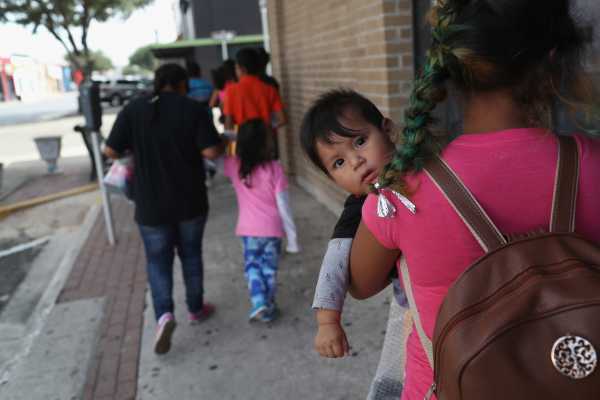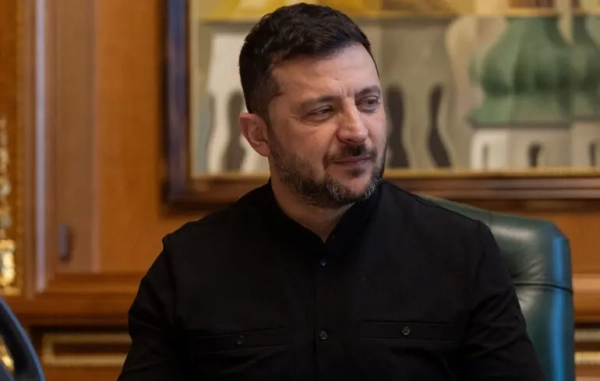
After several months of experimenting with punitive policies toward families coming to the US without papers — including separating thousands of children from their parents to detain and prosecute parents — the Trump administration is reluctantly returning to a practice it pejoratively calls “catch and release”: releasing families from immigration detention and allowing them to live in the US while they wait for their asylum claims to be adjudicated.
President Donald Trump and other top administration officials have spent months railing against the release of immigrant families as a recipe for widespread lawlessness. They claim that once a family is released from immigration, they’ll simply abscond into the US, skipping their appointed court dates, to live as unauthorized immigrants. The administration makes it seem like this is a deliberate strategy — a known end-run around existing immigration law that takes advantages of extra protections afforded to children, families, and asylum-seekers.
But a new study, compiled by a pair of legal advocacy groups, shows that isn’t the case, and that the administration doesn’t have to choose between separating immigrant families (or detaining them indefinitely) and making sure they show up to court. The administration has identified a real problem, but misunderstands, or misrepresents, the cause.
The study confirms that families who cross into the US without papers often miss their court dates, but offers suggestive qualitative evidence — collected from families who were contacted by attorneys and notified that they’d missed their court dates — that many families aren’t deliberately absconding at all.
They’re trying to stay in the system. It’s just that the system makes it too hard for them, then punishes them with an order of deportation when they fail. The people whom the Trump administration is painting as lawless “absconders” are often just lost, confused, and overwhelmed families in a strange land, working as hard as they can to be allowed to stay here but faced with legal and bureaucratic obstacles that make missing a court date an understandable outcome.
If the Trump administration is genuinely concerned about making sure asylum seekers stay in the legal process as long as they’re in the US, this is great news. It shows that they didn’t really need to use punitive tactics like separation and indefinite detention to accomplish that goal. And it shows that, now that they’ve started releasing families together again, they can devote their energy to smoothing the bureaucratic obstacles that are the real heart of the problem.
On the other hand, if the Trump administration continues to paint “catch and release” as a recipe for widespread lawlessness instead of trying to help families go through the system the right way, it will indicate that they are more interested in punishment than they are with ensuring the legal process gets followed.
Families not showing up to court dates is a real problem
Most people who are caught entering the US without papers can be deported quickly without a court hearing. But, to the apparent chagrin of President Trump, there are special protections for some groups, including asylum-seekers, to give them a chance to prove they’re eligible for legal status in the US.
Since the road to legal status runs through the incredibly backlogged immigration court system, that can take years, leaving the government with the question of what to do with migrants while their court cases are pending.
The way Trump tells it, any migrant who gets released from immigration detention before her court case is resolved will immediately escape into the US and evade detection by the authorities. “We release them. They go someplace into our country. They’re supposed to come back within two or three years for a court case, but nobody ever comes back,” Trump told a West Virginia crowd in April.
That’s somewhat overstated, but it doesn’t mean the problem isn’t real.
In fiscal year 2016, the last year for which full statistics are available, slightly more than a quarter of all cases decided in immigration courts ended with an order of deportation issued because the defendant hadn’t shown up to court (known as an in absentia order).
There aren’t separate in absentia statistics just for asylum-seekers caught entering the US. But statistics suggest that relatively few of the people who say they’re seeking asylum when they’re caught by a Border Patrol agent end up seeing the process of applying for asylum through to the end.
Less than 40 percent of people who pass the initial screening interview for asylum submit a written asylum application, which is a necessary step in the process even though they’ve passed the interview and gotten assigned a court hearing. (To the Trump administration, this is proof that the other 60 percent of people were just lying about being persecuted as an excuse to sneak into the US.)
The worst group for absenteeism appears to be families.
Two legal advocacy groups, CLINIC (the Catholic Legal Immigration Network, Inc.) and ASAP (the Asylum Seeker Advocacy Project of the Urban Justice Center), used the Freedom of Information Act to get data about all cases involving “adults with children” in the immigration court system from July 18, 2014, to November 2016 — the aftermath of the spring-summer 2014 wave of Central American children and families entering the US.
That data showed that more than 70 percent of families’ cases decided during that time ended with in absentia deportation orders. For comparison, during fiscal years 2015 and 2016 — i.e,. between October 2014 and September 2016 — the in absentia rate across all cases was only 26 percent.
Not showing up to court is the biggest reason families are losing their asylum cases
But just because the Trump administration is correct that people not showing up to court is a problem doesn’t mean it’s correct about why it’s happening.
And the data collected by CLINIC and ASAP suggests that families aren’t skipping out because they know their asylum cases are doomed. Oo the contrary, they end up dooming their asylum cases by missing their court dates.
Among all immigrants, in absentia cases made up only about a third of deportation orders. Among families, according to the new data, in absentia cases accounted for 83 percent of all removal orders.
Meanwhile, families were much more likely to win cases in which they did show up to court than other immigrants. During the period covered in the new report, 83 percent of families’ cases ended with removal orders. But if you take out the removal orders issued in absentia — and look only at cases where families did show up to court — only 40 percent of cases ended with a family ordered deported.
That’s a much bigger swing than immigration cases overall saw: In fiscal years 2015 and 2016, 70 percent of all cases ended in removal orders, but taking out the in absentia orders drops the removal rate to 59 percent.
The CLINIC/ASAP report says that during this time, asylum screening interviews in family detention centers had a higher approval rate than screening interviews among other border-crossers who claimed a fear of persecution (88 percent versus 77 percent). And the hearings most commonly skipped aren’t the final hearings at which an immigrant’s fate is set; they’re the initial hearings, known as “master calendar” hearings, in which the date for a full hearing is set months or years in the future. (The CLINIC report doesn’t offer data to prove that these are the most commonly missed hearings, but that characterization is consistent with other analyses.)
Most suggestively, families that had been in detention at some point, even if they had since been released, were more likely to show up to court than families who’d never been detained. They were also more likely to have legal representation, which CLINIC attributes to the fact that families in detention are often connected to pro bono attorneys and other resources that they can retain even after they get out.
The conclusion drawn by the advocacy groups is that people with attorneys were more likely to figure out how to make their court dates, and those without lawyers were at risk of getting swallowed up by the system.
Many families are trying to keep up with their cases, but are thwarted by bad information or unclear directions
In 2015, CLINIC and ASAP started reaching out to families released from detention to remind them of their court dates.
“ASAP and CLINIC consistently encountered families who had missed their hearings for several reasons, mostly outside of the families’ control,” the report says.
Some families missed their court dates because of confusion, often exacerbated by the effects of trauma from their home countries or other mental illness. Or because they worried that Immigration and Customs Enforcement (ICE) would arrest them if they showed up to court. That didn’t happen much under the Obama administration, when this report was conducted, but ICE has since done this to witnesses in criminal cases (and even victims seeking restraining orders) in some cases under Trump.
But in a lot of cases, a parent thought she was doing everything right and it just wasn’t enough.
If someone moves while their case is pending, the report says, they are “expected to update their address with up to five different entities—the immigration court, USCIS, ICE OCC, ICE ERO, and ISAP—using three different mediums—Form EOIR-33, Form AR-11, and oral or written notice.” That’s a lot of paperwork for someone without an attorney, especially someone whose English skills or general literacy may not be great. And immigrants may not even know they have to go through all that.
In one case CLINIC and ASAP encountered, a parent changed her address with ICE, but ICE didn’t tell her that she had to update it separately with the immigration court. So she missed the notice of her hearing date, and then missed the hearing. Another parent was told after she moved that she had a hearing in July 2016, only to discover too late that she’d missed a hearing she didn’t know about in August 2015.
In a third case in the CLINIC report, a mother was forced to move out of an abusive household in California but was unable to get the immigration judge to move her hearing to her new home in Virginia:
The Trump administration could choose to solve this problem in a nonpunitive way
In some cases that CLINIC and ASAP found, particular people were to blame: immigration judges who refused to move hearings, ineffective or fraudulent attorneys who got notices of court dates but simply never told their clients. But often, the advocates blame “structural and bureaucratic obstacles” — a system that is simply too complicated to allow families who want to show up to court to successfully do it.
When these obstacles are discovered, it’s often possible to fix the problem. ASAP and CLINIC challenged 46 in absentia removal orders, on behalf of 22 families, by the end of 2017. Ninety-six percent of the time they successfully got the government to reopen the family’s case.
These are probably the most compelling cases the advocates found. But they are a strong indication that at least some of the people who have been ordered deported because they didn’t show up to court are, in fact, trying to go through the asylum process the right way.
The Trump administration could adopt this as a premise of its asylum policy. It could use more discretion in figuring out which families are particularly likely to abscond, and focus enforcement resources on them, while making sure families who wanted to apply for asylum got the information they needed to do it outside of detention.
The administration could do a better job of coordinating between agencies so that migrants only needed to update their addresses once. It could adopt a case-management approach that assumed that people are trying to get through the system the right way and simply need a little help navigating it.
The Trump administration has not done that so far. It has instead adopted a blanket approach that assumes that any given family will evade the law if given the chance. It’s fighting in court to keep families under physical control in detention for as long as their cases take, while pressuring judges to speed up those cases so they can be deported more quickly, rather than ever getting released. And, when it fails, the administration is claiming that lawlessness is inevitable.
That’s the choice the administration has made. It’s the most punitive option available to them. It’s not necessarily the one best suited to the problem.
Sourse: vox.com






